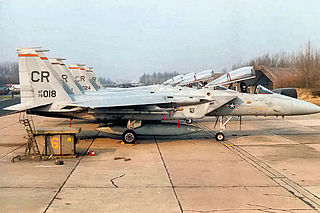
The 527th Space Aggressor Squadron is a non-flying United States Air Force unit assigned to the 57th Adversary Tactics Group. The 527 SAS is stationed at Schriever Air Force Base, Colorado, being a Geographically Separated Unit (GSU) of the 57 ATG, which is stationed at Nellis AFB, Nevada.

The United States Air Force's 36th Wing is the host wing for Andersen Air Force Base, Guam. It is part of Pacific Air Forces' Eleventh Air Force. The 36th Wing provides day-to-day mission support to more than 9,000 military, civilian, dependent and retired personnel and 15 associate units on the base.

Seventeenth Expeditionary Air Force is a numbered air force of the United States Air Force located at Ramstein Air Base, Germany. The command served the United States Air Forces in Europe during (1953–1996) and United States Air Forces Africa during 2008-2012. Upon reactivation on 1 October 2008, it became the air and space component of United States Africa Command. In this capacity, Seventeenth Air Force was referred to as U.S. Air Forces Africa (AFAFRICA). 17 AF was reformed in April 2012 to become the 17th Expeditionary Air Force, sharing a commander and headquarters with the Third Air Force.

The 103d Airlift Wing is a unit of the Connecticut Air National Guard, stationed at Bradley Air National Guard Base at Bradley International Airport, Windsor Locks, Connecticut. If activated to federal service with the United States Air Force, the 103 AW is operationally-gained by the Air Mobility Command (AMC).

The 26th Information Operations Wing is an inactive United States Air Force unit. Its last assignment was with United States Air Forces in Europe at Ramstein Air Base, Germany, where it was inactivated on 5 July 2006.

The 52d Fighter Wing is a wing of the United States Air Force stationed at Spangdahlem Air Base, Germany. It was activated in 1948, but derives significant elements of its history from the predecessor Second World War 52d Fighter Group, which is now the 52d Operations Group, subordinate to the wing.

The 22d Fighter Squadron is an inactive United States Air Force unit. It was last assigned to the 52d Operations Group and stationed at Spangdahlem Air Base, Germany. It was inactivated on 13 August 2010. At various times during its existence, the squadron has gone by colloquial names "Stingers", "Adlers", "Bees", "Bumblebees" and "The BIG 22: Last of the Red Hot Fighter Squadrons".

The 23d Fighter Squadron is an inactive United States Air Force unit. It was last assigned to the 52d Operations Group and stationed at Spangdahlem Air Base, Germany. It was inactivated on 13 August 2010.

The 81st Fighter Squadron is a flying squadron of the United States Air Force. It is Geographically Separated Unit of the 14th Flying Training Wing at Columbus Air Force Base, Mississippi, and operates the A-29 Super Tucano aircraft conducting close air support training to the Afghan Air Force as part of ISAF. It is stationed at Moody Air Force Base, Georgia.

The 510th Fighter Squadron is part of the 31st Operations Group at Aviano Air Base, Italy. It is a combat-ready F-16CM fighter squadron prepared to deploy and fly combat sorties as tasked by NATO and US combatant commanders. The squadron employs a full range of the latest state-of-the-art precision ordnance.

The 525th Fighter Squadron is a United States Air Force unit. It is assigned to the 3d Operations Group at Elmendorf Air Force Base, Alaska. The squadron was first activated as the 309th Bombardment Squadron in February 1942. After training in the United States, it deployed to the Mediterranean Theater of Operations, where it became the 525th Fighter-Bomber Squadron and engaged in combat until the spring of 1945, earning two Distinguished Unit Citations. After VE Day, the squadron became part of the occupation forces in Germany. Briefly inactivated in 1946, it returned to Germany a few months later.

The 32d Air Operations Squadron is an inactive United States Air Force unit. Its last assignment was with 32d Air Operations Group, based at Ramstein Air Base, Germany. It was inactivated on 1 November 2005.

The 32d Intelligence Squadron is a unit of the United States Air Force 707th Intelligence, Surveillance and Reconnaissance Group located at Fort George G. Meade, Maryland.

The 401st Air Expeditionary Group is a provisional United States Air Force unit assigned to United States Air Forces in Europe to be activated or inactivated at any time as needed. It is stationed at Ramstein Air Base, Germany.

The 388th Operations Group is the flying component of the 388th Fighter Wing, assigned to the Air Combat Command Twelfth Air Force. The group is stationed at Hill Air Force Base, Utah.

The 36th Operations Group is the operational component of the 36th Wing, assigned to the United States Air Force Pacific Air Forces. The group is stationed at Andersen Air Force Base, Guam.

The 480th Fighter Squadron is an active United States Air Force unit. It is assigned to the 52d Operations Group, stationed at Spangdahlem Air Base, Germany. It was reactivated on 13 August 2010.

The 39th Tactical Electronic Warfare Squadron is an inactive United States Air Force unit. It was last assigned to the 52d Tactical Fighter Wing at Spangdahlem Air Base, Germany, where it was inactivated in January 1973.

The 1st Tactical Missile Squadron is an inactive United States Air Force unit. It was last assigned to the 585th Tactical Missile Group at Bitburg Air Base, West Germany, where it was inactivated on 18 June 1958.


































